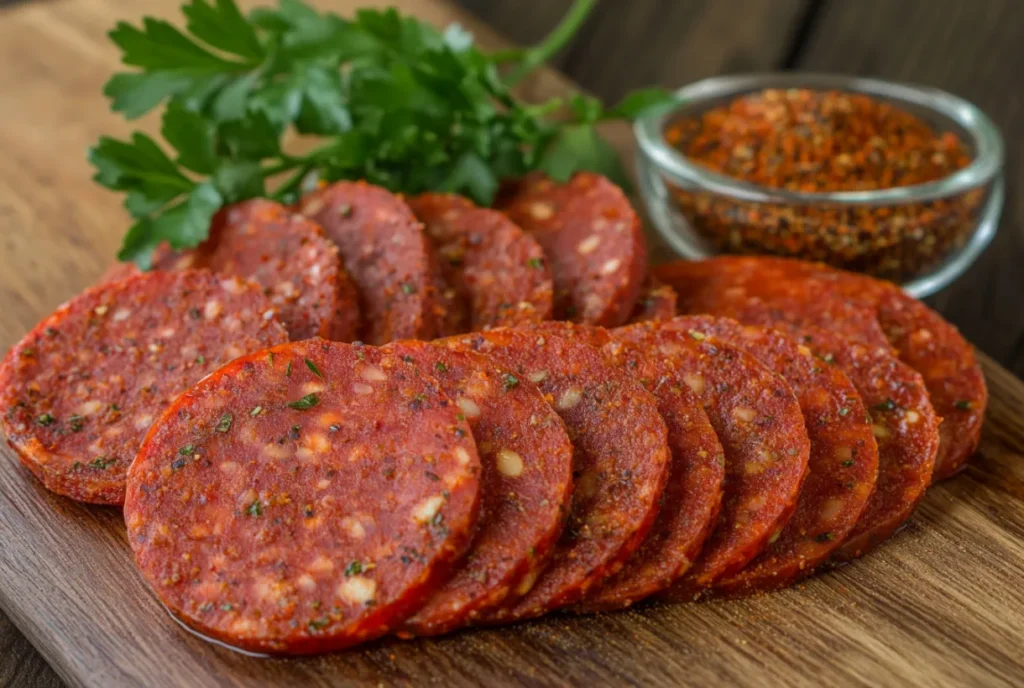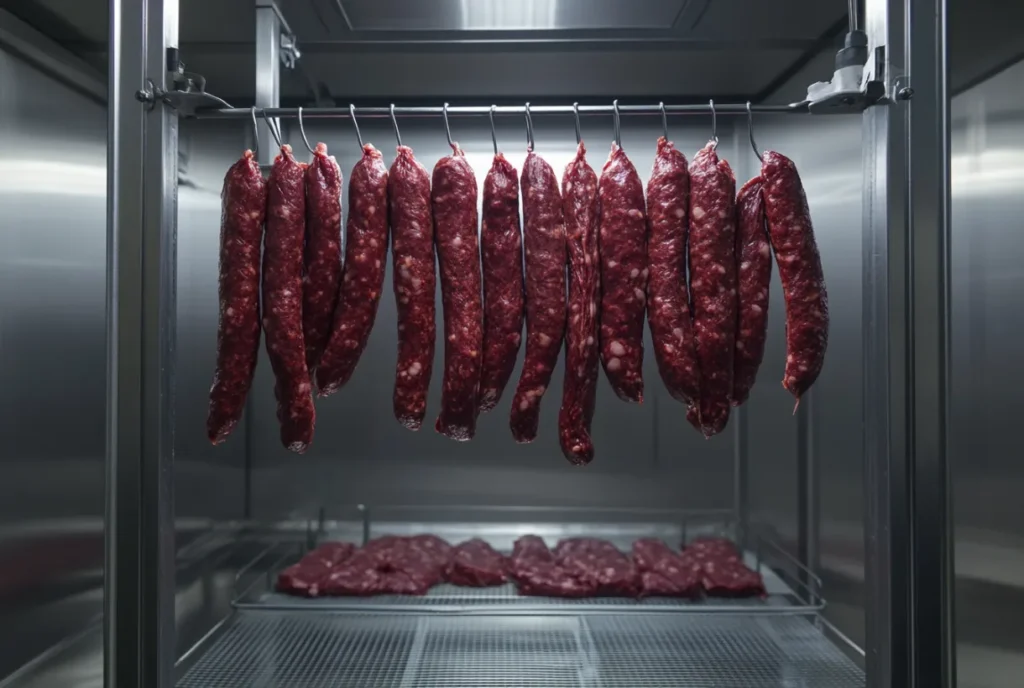
Beef pepperoni is a flavor-packed alternative to the traditional beef-based version. With its smoky aroma, slightly spicy notes, and satisfying chew, it’s no wonder many people are curious about its unique taste. In this article, we’ll dive deep into what makes beef pepperoni so special. From its flavor profile and texture to the spices that set it apart, you’ll discover everything you need to know. We’ll also explore its culinary uses, how it compares to beef pepperoni, and much more.
Part 1: The Flavor Profile of Beef Pepperoni
Smoky and Savory Notes
When asking, “What does beef pepperoni taste like?“, the first thing that comes to mind is its smoky and savory essence. Unlike its beef counterpart, beef pepperoni boasts a richer and more robust flavor. The smokiness comes from the curing process, where traditional wood smoking imparts a deep, complex taste. This smoky aroma is balanced by a subtle tanginess from the fermentation process, making each bite a flavorful experience.
The seasoning in beef pepperoni plays a big role in its unique taste. Spices like paprika, garlic powder, and fennel seeds create a harmonious blend of savory and slightly sweet flavors. These spices ensure that beef pepperoni has a punchy, bold taste without overwhelming your palate.
Spicy and Tangy Undertones
Beef pepperoni also has a mild spiciness, thanks to cayenne pepper and crushed red pepper flakes. This subtle heat adds a kick, making it ideal for pizza toppings, snacks, or sandwiches. The tangy undertones, which develop during fermentation, help balance the spice, giving the pepperoni a well-rounded flavor.
Additionally, beef pepperoni’s texture enhances its taste. It’s chewy yet tender, with a slight crispness when cooked. Whether you enjoy it fresh out of the package or sizzling on a pizza, beef pepperoni delivers a satisfying mouthfeel that pairs perfectly with its rich taste.
Beef pepperoni offers a unique flavor profile that sets it apart from its beef counterpart. Understanding its taste involves exploring its ingredients, preparation methods, and culinary applications. In this article, we’ll delve into the nuances of beef pepperoni, comparing it to traditional beef versions, and discussing its various uses in the kitchen.

Flavor Profile of Beef Pepperoni
Ingredients and Seasoning
Beef pepperoni is crafted from finely ground beef, seasoned with a blend of spices such as paprika, garlic powder, and cayenne pepper. This combination imparts a spicy and smoky flavor, with a hint of sweetness from the paprika. The absence of beef allows the richness of the beef to shine through, offering a distinct taste experience.
Texture and Appearance
In terms of texture, beef pepperoni is typically firm yet tender, with a slightly chewy bite. Its color ranges from deep red to reddish-brown, attributed to the curing process and the spices used. When cooked, especially as a pizza topping, it can develop crispy edges while retaining a juicy center, enhancing its overall appeal.
Comparing Beef and beef Pepperoni
Taste Differences
While both beef and beef pepperoni share a similar spice profile, the underlying flavors differ due to the base meat. beef pepperoni tends to have a milder and sweeter taste, whereas beef pepperoni offers a bolder and more robust flavor. This intensity makes beef pepperoni a preferred choice for those seeking a more pronounced taste in their dishes.
Dietary Considerations
Beef pepperoni serves as an alternative for individuals who avoid beef due to dietary restrictions or personal preferences. It’s essential to check for halal certification if adhering to specific dietary laws, as not all beef pepperoni products meet these standards.
Culinary Uses of Beef Pepperoni
Traditional Applications
Beef pepperoni is a popular topping for pizzas, providing a savory and spicy element that complements the cheesy and tomato-based components. It’s also commonly used in sandwiches, adding a flavorful punch to subs and paninis.
Creative Recipes
Beyond traditional uses, beef pepperoni can be incorporated into various dishes:
- Pepperoni Pasta Bake: Combine cooked pasta with marinara sauce, sliced beef pepperoni, and mozzarella cheese. Bake until bubbly for a hearty meal.
- Pepperoni-Stuffed Mushrooms: Fill mushroom caps with a mixture of chopped beef pepperoni, cream cheese, and herbs. Bake until the mushrooms are tender and the filling is golden.
- Pepperoni Breakfast Casserole: Layer hash browns, eggs, cheese, and beef pepperoni in a baking dish. Bake until set for a flavorful breakfast option.
For more delicious recipes, check out our recipe article.
Conclusion
In summary, beef pepperoni offers a distinctive and robust flavor profile that appeals to those seeking a bolder taste. Its versatility in various culinary applications makes it a valuable ingredient in the kitchen. Whether used traditionally on pizzas or creatively in other dishes, beef pepperoni provides a satisfying and flavorful experience.
FAQs
What is the meat in pepperoni?
Traditional pepperoni is made from a mixture of beef and beef. However, variations exist, including all-beef or turkey-based pepperoni, catering to different dietary preferences.
Is pepperoni beef halal?
Not all beef pepperoni is halal. To ensure it meets halal standards, look for products that are certified halal, indicating they adhere to specific dietary laws.
How to replace pepperoni?
If you’re seeking alternatives to traditional pepperoni, consider using turkey pepperoni, chicken sausage, or plant-based pepperoni substitutes. These options can provide similar flavors while accommodating dietary restrictions.
What does beef pepperoni taste like?
Beef pepperoni has a bold, spicy, and smoky flavor, with a richness that distinguishes it from beef-based versions. Its robust taste makes it a popular choice for those seeking a more pronounced flavor in their dishes.
Beef pepperoni offers a unique flavor profile that sets it apart from its beef counterpart. Understanding its taste involves exploring its ingredients, preparation methods, and culinary applications. In this article, we’ll delve into the nuances of beef pepperoni, comparing it to traditional beef versions, and discussing its various uses in the kitchen.
Flavor Profile of Beef Pepperoni
Ingredients and Seasoning
Beef pepperoni is crafted from finely ground beef, seasoned with a blend of spices such as paprika, garlic powder, and cayenne pepper. This combination imparts a spicy and smoky flavor, with a hint of sweetness from the paprika. The absence of beef allows the richness of the beef to shine through, offering a distinct taste experience.
Texture and Appearance
In terms of texture, beef pepperoni is typically firm yet tender, with a slightly chewy bite. Its color ranges from deep red to reddish-brown, attributed to the curing process and the spices used. When cooked, especially as a pizza topping, it can develop crispy edges while retaining a juicy center, enhancing its overall appeal.
Comparing Beef and beef Pepperoni
Taste Differences
While both beef and beef pepperoni share a similar spice profile, the underlying flavors differ due to the base meat. beef pepperoni tends to have a milder and sweeter taste, whereas beef pepperoni offers a bolder and more robust flavor. This intensity makes beef pepperoni a preferred choice for those seeking a more pronounced taste in their dishes.
Dietary Considerations
Beef pepperoni serves as an alternative for individuals who avoid beef due to dietary restrictions or personal preferences. It’s essential to check for halal certification if adhering to specific dietary laws, as not all beef pepperoni products meet these standards.
Culinary Uses of Beef Pepperoni
Traditional Applications
Beef pepperoni is a popular topping for pizzas, providing a savory and spicy element that complements the cheesy and tomato-based components. It’s also commonly used in sandwiches, adding a flavorful punch to subs and paninis.
Creative Recipes
Beyond traditional uses, beef pepperoni can be incorporated into various dishes:
- Pepperoni Pasta Bake: Combine cooked pasta with marinara sauce, sliced beef pepperoni, and mozzarella cheese. Bake until bubbly for a hearty meal.
- Pepperoni-Stuffed Mushrooms: Fill mushroom caps with a mixture of chopped beef pepperoni, cream cheese, and herbs. Bake until the mushrooms are tender and the filling is golden.
- Pepperoni Breakfast Casserole: Layer hash browns, eggs, cheese, and diced beef pepperoni in a baking dish. Bake until set for a flavorful start to your day.
For more delicious recipes, check out our Boursin Cheese Pasta Recipe.
Part 6: Frequently Asked Questions (FAQs) (400 Words)
What Does Beef Pepperoni Taste Like?
When you bite into beef pepperoni, you’ll immediately notice its rich, smoky, and savory flavor. The boldness of the beef is complemented by a blend of spices like paprika, garlic, and cayenne pepper. It’s slightly tangy due to the curing process, with a mild heat that adds an extra layer of flavor. Compared to beef pepperoni, beef pepperoni has a denser texture and a more robust taste, making it a favorite for those who prefer bold, savory snacks.
What Is the Meat in Pepperoni?
Traditional pepperoni is typically made from a mix of beef and beef. However, beef pepperoni is made exclusively from beef, catering to dietary preferences or restrictions. This version offers a unique flavor profile that emphasizes the richness of the beef, making it distinct from the standard blend.
Is Beef Pepperoni Halal?
Yes, beef pepperoni can be halal if it’s made following Islamic dietary laws. Halal-certified products ensure that the beef is sourced and processed according to these guidelines. It’s important to check product labels or look for certifications to confirm that the pepperoni meets halal standards.
How Can You Replace Traditional Pepperoni?
For those looking to avoid beef or explore new flavors, beef pepperoni is an excellent substitute. Its bold and smoky taste works well in pizzas, sandwiches, and appetizers. Other alternatives include turkey pepperoni for a leaner option or plant-based pepperoni for vegetarian and vegan diets. These options ensure everyone can enjoy pepperoni-flavored dishes, regardless of their dietary needs.

Part 7: Making Beef Pepperoni at Home (400 Words)
Ingredients and Equipment Needed
Making beef pepperoni at home is easier than you might think. To get started, gather these ingredients:
- 1 pound of lean ground beef
- 1 tablespoon of paprika
- 1 teaspoon garlic powder
- 1 teaspoon fennel seeds
- 1 teaspoon curing salt
- ½ teaspoon cayenne pepper
- Natural or synthetic casings
For equipment, you’ll need a meat grinder, sausage stuffer, and a smoker or oven with a drying function.
Step-by-Step Process
- Prepare the Meat Mixture: Combine the ground beef with all the spices and curing salt. Mix thoroughly to ensure even seasoning.
- Stuff the Casings: Using a sausage stuffer, fill the casings with the seasoned meat mixture. Tie the ends securely to prevent air pockets.
- Ferment the Sausages: Hang the sausages in a cool, controlled environment to ferment. This step enhances the tangy flavor of the pepperoni.
- Smoke or Cook: Place the sausages in a smoker for a rich, smoky flavor. Alternatively, bake them in an oven at a low temperature until fully dried.
- Dry and Store: Let the sausages dry completely before storing them in an airtight container. Homemade beef pepperoni can be refrigerated for up to two weeks.
Tips for Success
- Use high-quality beef for the best flavor and texture.
- Ensure the curing process is done correctly to prevent spoilage.
- Experiment with spice blends to customize the flavor of your homemade pepperoni.
Part 8: Exploring Global Variations of Pepperoni (300 Words)
Regional Variations of Pepperoni
Pepperoni, including its beef-based version, has inspired countless regional adaptations worldwide. While traditional pepperoni is a distinctly American invention, other cultures have created their own takes on spiced, cured sausages.
In Italy, cured meats like salami and soppressata offer flavors that are similar to beef pepperoni but with unique regional spice blends. These Italian sausages often have a coarser texture and feature aromatic herbs like rosemary or oregano.
In Spain, chorizo is a popular cured meat that rivals pepperoni in boldness. Spanish chorizo has a smoky, paprika-forward flavor, which pairs beautifully with a variety of dishes, much like beef pepperoni. While it doesn’t taste exactly the same, it offers a similarly savory and spicy kick.
Modern Pepperoni Alternatives
If you’re wondering, “What does beef pepperoni taste like?”, it’s worth exploring modern alternatives that cater to evolving dietary preferences. Plant-based pepperoni, for instance, replicates the flavor of beef pepperoni using soy or pea protein, combined with classic spices like garlic and paprika. Turkey pepperoni is another popular option, offering a lighter, leaner taste that still delivers on flavor.
These global and alternative versions highlight the universal love for pepperoni-style cured meats. They demonstrate how this versatile ingredient has evolved to suit different tastes and preferences.
Part 9: The Future of Beef Pepperoni
Market Trends
The popularity of beef pepperoni continues to grow as consumers look for beef-free alternatives and bold flavor profiles. Many brands are focusing on offering Halal-certified or Kosher options to cater to a more diverse audience. Additionally, there’s a rising interest in clean-label products, with companies emphasizing all-natural ingredients and sustainable practices.
This shift reflects broader consumer trends. Shoppers are not only curious about what beef pepperoni tastes like but also where it comes from and how it’s made. Transparency in sourcing and production is becoming a key selling point.
Innovations in Pepperoni Production
Advancements in food technology are making it possible to produce beef pepperoni with improved flavor and texture. Enhanced curing methods and innovative spice blends are allowing manufacturers to create products that are more flavorful and appealing than ever. Some companies are even exploring plant-based alternatives that mimic the taste and texture of beef pepperoni with remarkable accuracy.
Sustainability Considerations
Sustainability is also playing a major role in the future of beef pepperoni. From ethical sourcing of beef to using eco-friendly packaging, many producers are adopting practices that minimize environmental impact. This ensures that consumers can enjoy their favorite foods without compromising on their values.

